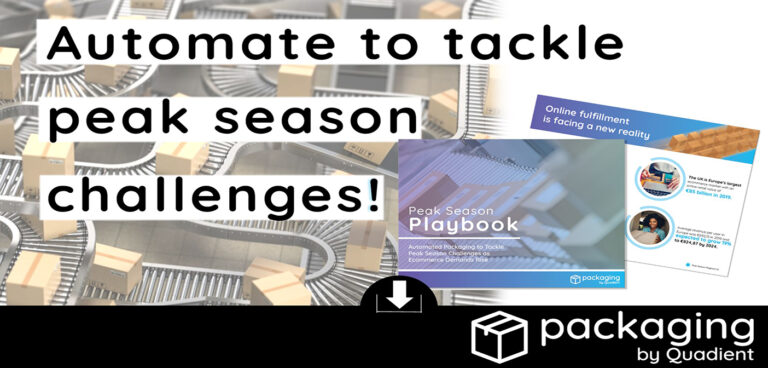Online fulfilment is facing a new reality; one of frequent and dramatic spikes in demand and this is causing retailers significant challenges in the packing area. How can ecommerce businesses successfully hit these extreme peaks when labour resources are becoming increasingly scarce?
- Peaks are more difficult to predict than before.
- Peaks are measured by the hour instead of week or time of year.
- Packaging is often the bottleneck to meet the promised delivery time.
- Physical space holds packaging operations back from temporarily scaling up.
- Labour availability complicates the scaling up from packaging operations temporarily.
Do you recognise one or more of these issues? Then keep on reading to find the best solution for your packaging challenges.
Challenges
According to the latest figures from the UK Office for National Statistics (ONS), online sales as a proportion of all retailing increased to 19.2% in October 2019, up one per cent on figures for October 2018. But this steady progression of online activity is not spread evenly through the year. Black Friday and Cyber Monday have become notorious seasonal events, Christmas and Easter are fairly predictable, but retailers can also face sudden surges in demand as a result of unexpected events as diverse as heat waves, sporting successes, hit TV shows, celebrity endorsements or pandemic regulations. With ever-tighter delivery promises, peaks are no longer measured in weeks or days, but by the hour.
These peaks stress test the whole fulfilment and delivery process and nowhere is this more acutely felt than in the packing area. Constructing boxes, packing, weighing, sealing and labelling manually is a slow process, and few shippers have either the physical space, now even made harder by social distancing regulations, or the available labour to create additional packing stations for what may be only a few days’ work. Finding a flexible labour force, available at short notice, is also becoming increasingly difficult as a result of Brexit. So, how will online retailers cope with the new reality of frequent and dramatic spikes in demand?
The case for greater use of automation in the packing area is compelling. However, simple size-constrained machines using only one-size of box does not cater for the wide variety of products and order sizes experienced by most online retailers. If demand for smaller items to be packed exceeds the capacity of the relevant machine, the shipper has no option but to move up a box size, or two, or three.
Waste of materials
The consequences are not good. It is understood that 60% of ecommerce deliveries are by volume at least a quarter composed of bubble-wrap, polystyrene beads or just fresh air, resulting in using much more cardboard than necessary. Much of the dunnage is essentially non-recyclable, but without it the damage rate for small items slamming about in large boxes, already high, becomes unacceptable to consumers and creates an ever-bigger returns problem.
What can be done?
The case for a fast, efficient, economical and secure means of automating the packaging and labelling of online orders is convincing – but how can it be done? Can boxes be individually made to the exact size required for each order, secured, weighed and labelled automatically at speeds capable of efficiently and cost-effectively matching peak volumes? Effectively, could a machine flex to demand, even at volumes of up to a thousand packages an hour? The answer is yes.
Packaging by Quadient – formerly Neopost – has introduced the CVP Everest, a high velocity fit-to-size ‘auto-boxing’ system capable of tailor-making over 1,100 ecommerce packages per hour. The system scans and measures the item, or group of items, to be packed and calculates the ‘best fit’ box shape and size. Material for the box and lid is cut and creased to size, erected around the item(s) and the lid glue-sealed – which is faster and more recyclable than using tape. Parcels are weighed, labelled and ready to be shipped.
Addressing the waste problem:
- Cardboard usage cut by an average of 20%.
- No need for void fill.
- Volume reduction by 50%.
- Reduced shipping costs by maximising use of truck/trailer space.
Addressing the labour problem at peak-times, but also operating off-peak:
- Replaces on average 20 to 30 manual packing stations
- Packs up to 1,100 parcels per hour
- Redeployment labour to other tasks
By choosing an automated solution to ‘right-size’ ecommerce deliveries, retailers can meet their fulfilment promises, even in the peaks, while respecting the environment, reducing transit damage, and saving money.
Are you ready to solve your peak packaging problems? Download our PEAK SEASON PLAYBOOK and learn all about our automated packaging solutions at Packaging by Quadient







